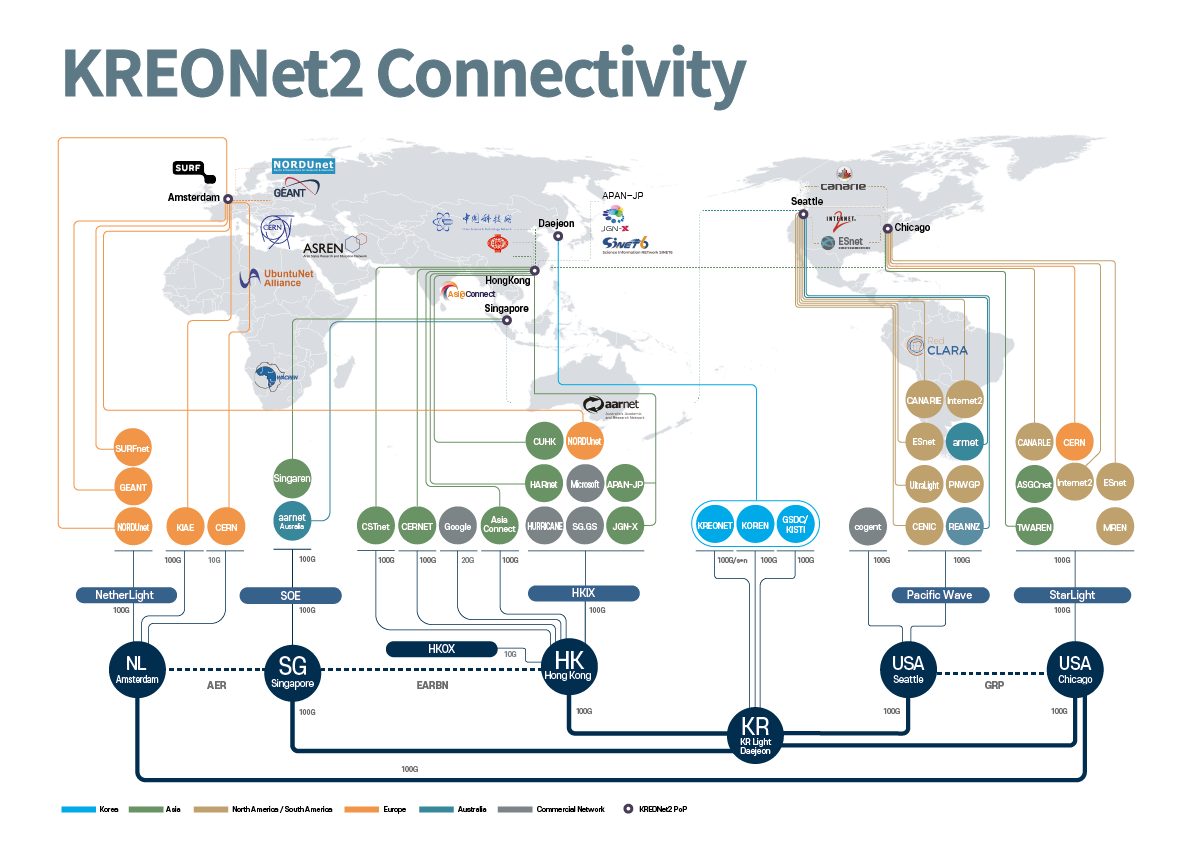KREONET International Network
Overview
In 2005, the Global Ring Network for Advanced Applications Development (GLORIAD) project was initiated to enable global collaborative research in large-scale scientific fields such as high-energy physics, astronomy and space science, climate science, and nuclear fusion. With the participation of research networks from 15 countries—including the United States, China, Russia, Canada, and the Netherlands—the project established 10 Gbps interconnections worldwide.
* GLORIAD: Global Ring Network for Advanced Applications Development
Since 2023, the KREONet2, KREONET International Network, has evolved into a global 100 Gbps ring, connecting (Amsterdam) - Asia (Singapore, Hong Kong) - South Korea (Daejeon) - North America (Chicago, Seattle) - Europe (Amsterdam), providing an essential backbone for global scientific research collaboration.
Infrastructure
- 100 Gbps international backbone circuits: Hong Kong – Daejeon, Singapore – Daejeon, Daejeon – Chicago, Daejeon – Seattle, Chicago – Amsterdam, Amsterdam – Singapore
- 6 International Points of Presence (PoP): Singapore, Hong Kong (China), Daejeon (Korea), Chicago and Seattle (USA), Amsterdam (Netherlands)
* The infrastructure is composed of optical transport equipment, high-performance switches and routers, and performance measurement servers.

Key Areas of Support for State-of-the art Science and Technology including Global Big Science
KREONET’s high-speed network supports a wide range of research domains by enabling the rapid transmission of large-scale scientific data, fostering groundbreaking discoveries and innovations in collaboration with global research institutions.
1. High-Energy Physics:
- CERN’s Large Hadron Collider (LHC) and High-Luminosity LHC (HL-LHC)
- SuperKEKB accelerator and KEK’s Belle II Experiment
- Pohang Accelerator Laboratory’s 4th Generation Synchrotron Radiation Accelerator (PAL-XFEL)
- Institute for Basic Science (IBS)’s RAON (Rare isotope Accelerator complex for ON-line experiments) Heavy Ion Accelerator
2. Nuclear Fusion:
- Korean Superconducting Tokamak Advanced Research (KSTAR)
- International Thermonuclear Experimental Reactor (ITER)
3. Astronomy and Space Science:
- Korean VLBI Network (KVN)
- Sloan Digital Sky Survey (SDSS)
- Square Kilometer Array (SKA)
- Large Synoptic Survey Telescope (LSST)
- East Asian VLBI Network (EAVN)
- Korea Microlensing Telescope Network (KMTNet) for exoplanet exploration
- Solar and Space Environment Monitoring
- cosmological hydrodynamical simulation DARWIN-1
4. Climate and Weather Science:
- Research in climate prediction models connected to the National Meteorological Supercomputer
- Atmospheric and oceanic numerical modeling
- Past, present, and future changes in the Earth’s climate system
- Disaster broadcasting response system
5. Aerospace:
- National Satellite Ground Network
- Research on the Korean Launch Vehicle (Nuri)
- Operation of satellite tracking stations
- Korea Pathfinder Lunar Orbiter (KPLO)
6. Bioinformatics and Genomics:
- International Cancer Genome Consortium (ICGC)
- Pan-Cancer Analysis of Whole Genomes (PCAWG)
- Cancer Genome Regional Data Processing Centers (RDPC)
- National Bio Big Data and Bio Station Project
- Cryo-electron micros (Cryo-EM)
7. Optical Sensing and Optical Clock Comparison:
- Inter-continental Optical Clock Comparison using Broadband VLBI (contributing to the redefinition of the second)
- Optical fibers using Distributed Vibration Sensing (DVS)
8. Next Generation Network:
- SCION (Scalability, Control, and Isolation On Next-generation networks)
- Untact Realistic OpenXR Platform
- Remote Control System for Autonomous Driving

